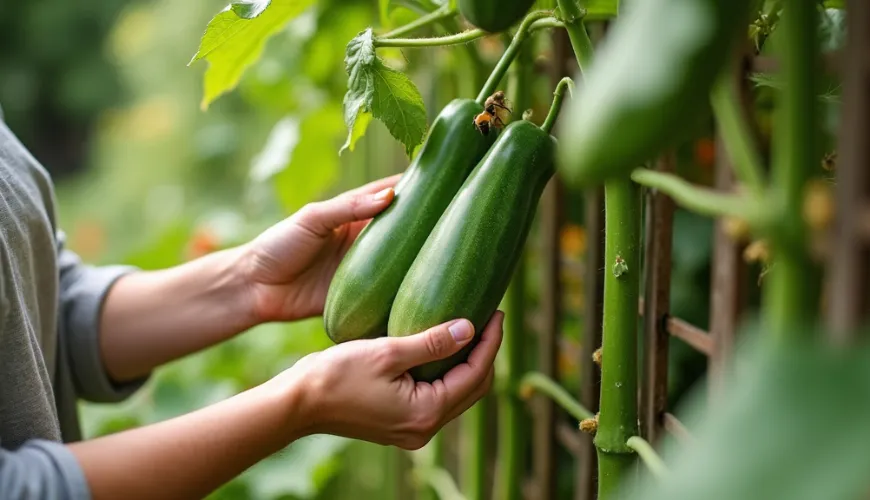
Cucamelon as a Taste Experience – From Garden to Your Table

Cucamelon: The Adorable Mini Cucumber Conquering Gardens and Hearts
At first glance, it looks like a tiny melon. On second glance, it resembles a cucumber – and in fact, it's both. Cucamelon, sometimes referred to in Czech as okurkomeloun, Mexican mini cucumber, or melon cucumber, is a plant that has been gaining increasing popularity among gardeners and lovers of unconventional vegetables in recent years. Not only is it visually charming, but it's also tasty, low-maintenance, and surprisingly versatile in the kitchen.
When the first cucamelon seedlings appear in garden centers or online seed shops in spring, they quickly find their way into the hands of eager growers. This plant is not just an eye-catching addition to a garden bed or balcony garden – it is also a beautiful example of how cultivation can be sustainable, joyful, and delicious at the same time.
What is cucamelon and where does it come from?
Cucamelon (Melothria scabra) hails from Latin America, particularly the region of Mexico and Central America, where it is known as sandía ratón, or "mouse melon." Although it looks like a mini watermelon, its taste will immediately convince you that it is actually a tiny tangy cucumber with a hint of citrus. It's not a new modern breeding fad – locals have been cultivating this plant for centuries.
The size resembles a grape, with a crunchy skin and juicy flesh. It's ideal for summer salads, cocktail garnishes, and is also excellent pickled. Moreover, due to its size and appearance, it is often a hit with children who otherwise tend to refuse vegetables.
Growing cucamelon
One of the reasons cucamelon is gaining popularity is its low maintenance. Cucamelon growers' experiences show that this plant is resistant to pests, handles heat and weather fluctuations better than common salad cucumbers, and does not require any special care. So how to go about it?
Start with quality seeds. On the Czech market, cucamelon is now commonly available from specialized online seed shops, such as Ferwer. Cucamelon seeds are sown similarly to tomatoes – ideally in March or April, in seed trays under cover. They require warmth to germinate (ideally around 22–25 °C), so it's good to place them on a sunny windowsill or in a greenhouse.
After approximately two to three weeks, small seedlings will sprout, which can be gradually transplanted into larger pots. It is recommended to plant them outdoors only after the last frost, in the second half of May, as cucamelon is sensitive to frost. An ideal location is a sunny bed or a larger growing container on a balcony or terrace.
Cucamelon grows as a climbing vine, similar to cucumbers or peas, so it's advisable to provide it with support. A trellis, strings, or pergola will allow it to grow upwards and also make harvesting easier. The plant blooms with small yellow flowers, and fruits appear approximately 60 to 70 days after planting.
Growers' experiences
Many gardeners who tried cucamelon for the first time admit that it pleasantly surprised them. "We planted it out of curiosity, but ended up harvesting a handful of small cucumbers every day. The kids picked them straight from the garden like candy," shares her cucamelon experiences Mrs. Andrea from South Bohemia.
Some growers note that the first year's harvest might be average, but in subsequent years, if you grow the plant from your own seeds or cultivate it in a favorable climate, the yield is richer. With proper care (regular watering, plenty of sun, and support), a single plant can produce hundreds of fruits.
And the best part? Cucamelon is largely self-pollinating, meaning you don't need a large swarm of bees or additional plants for pollination. However, the presence of pollinators has been shown to increase yield – another point for a sustainable garden full of life.
Culinary uses
Cucamelon is not just a garden ornament but also a kitchen delight. Its refreshing, slightly tangy taste lends itself to a wide range of uses – whether fresh or pickled. In summer salads, it creates an interesting contrast to sweet tomatoes and crispy lettuce. It’s perfect as a natural "stirrer" in mixed drinks, where it captivates with both flavor and appearance. You can also pickle it like classic cucumbers – whether in a sweet and sour brine or perhaps with chili and garlic.
Fermentation enthusiasts praise how cucamelon behaves during pickling – it retains its firm texture and gains an even richer flavor profile. What’s more: it can last for several weeks in the fridge after harvesting without losing quality.
Sustainability and a return to crop diversity
At a time when more and more people are questioning how to eat healthier and more sustainably, cucamelon emerges as a small but powerful symbol of change. It belongs to the category of so-called heirloom varieties, which are not the result of genetic modifications but a long process of natural selection and traditional cultivation.
Its minimal need for chemical treatments and ability to grow in limited spaces make it an ideal plant for anyone looking to reduce their ecological footprint. While standard cucumbers often require a lot of water and soil, cucamelon thrives with minimal resources and offers a bountiful harvest full of flavor and vitamins.
Furthermore, its cultivation supports biodiversity. As permaculture expert and author of books on edible gardens Helena Vlašínová reminds us: "A variety of crops in the garden not only ensures a more diverse diet but also greater stability of the entire ecosystem."
Why should you try cucamelon?
If you haven't heard of this plant yet, now is the perfect time to change that. Cucamelon seeds are readily available today, and even a beginner can manage to grow them. If you have doubts about whether you can successfully cultivate them, try reading discussions or reviews from other growers – most agree that cucamelon is a joy to grow and harvest.
Moreover, it's a way to enrich your family meal plan with an unusual, healthy, and natural ingredient. As we return to home cooking, seasonal ingredients, and caring for our own health, cucamelon represents one of those small but meaningful steps in the right direction.
So, will you try something truly new and delicious in your garden this year?

